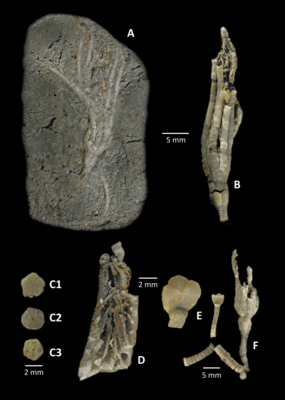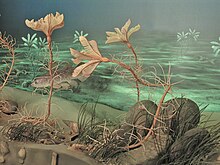Holocrinus wagneri
| Holocrinus wagneri | ||||||||||||
|---|---|---|---|---|---|---|---|---|---|---|---|---|

Holocrinus wagneri (BENECKE, 1887), Lower Muschelkalk, Elfershausen, Museum Terra Triassica Euerdorf : A: Krone, SMTE 5825-1-5; B: crown, SMTE 5825-1-38; C1-C3: Columnale, C1, SMTE 5825-1-32A; C2, SMTE 5825-1-47B; C3, SMTE 5825-1-41; D: arms with pinnulae, 5825-1-33; E: Basalia and Infrabasalia with stem, SMTE 5825-1-32; F: crown with stem, SMTE 5825-1-47A. |
||||||||||||
| Temporal occurrence | ||||||||||||
| Anisium ( Bithynium ), Triassic | ||||||||||||
| Locations | ||||||||||||
|
||||||||||||
| Systematics | ||||||||||||
|
||||||||||||
| Scientific name | ||||||||||||
| Holocrinus wagneri | ||||||||||||
| ( Benecke , 1887) |
Holocrinus wagneri ( Benecke , 1887) is one of eight currently validly described species of the genus Holocrinus Wachsmuth & Springer belongingto the tribe of echinoderms (Echinodermata Bruguière , 1791 [ex Klein , 1734]) and the class of sea lilies (Crinoidea Miller , 1821), 1886. The occurrence of this genus has been documented from the Olenekian up to and including Ladinian in Europe, Asia and North America. The species Holocrinus wagneri has so far only been detected in the Lower Muschelkalk (early anisium (Bithynium)) in Germany.
history
In the years from 1881, the teacher Richard Wagner , who taught mathematics and natural sciences at the agricultural school in Zwätz near Jena , researched the geology and paleontology of the area around Jena. During his research in the Lower Muschelkalk on the north-western slope of the foothills of the Kernberg near Jena facing towards Jena, he discovered the occurrence of remains of fossil sea lilies in two lens-shaped deposits. At the suggestion of Ernst Erhard Schmid , after a brief communication to Emanuel Kayser in 1885 , he published his state of knowledge on the occurrence of the crinoid remains found in the individual layers of the Lower Muschelkalk in the vicinity of Jena and described this sea lily as Encrinus gracilis v. Book. In 1887 Ernst Wilhelm Benecke recognized the independence of this delicate sea lily and named it Encrinus Wagneri in a lecture in honor of Richard Wagner . In autumn 1887 Richard Wagner succeeded in finding a sea lily of the same species with preserved goblet cover at the same level in the Rosental near Zwätz, which he published together with a copy of the Kernberge (1887, Fig. 2) in a letter to Wilhelm Dames . In 1893 Otto Jaekel recognized that the genus characteristics of the sea lilies discovered by Richard Wagner corresponded to the genus Holocrinus established by Charles Wachsmuth and Frank Springer in 1886 .
The new species of sea lily discovered by Richard Wagner is currently still valid and, following its assignment to the genus Holocrinus in 1893 , can be referred to as Holocrinus wagneri .
description
Holocrinus wagneri is one of the sea lilies that carry cirrus. In contrast to the species Moenocrinus deeckei Hildebrand , 1926 , belonging to the same family of the Holocrinidae Jaekel , 1918, in which the basalia is more than three times as long as the stem wide, Holocrinus wagneri has small, nut-shaped calyxes about 13 mm long and 8 mm width. Your arms become quite long. With a cup height of 5 mm, arm lengths of up to 44 mm were found. The stem has an alternation of more strongly and less strongly developed limbs, whereas the cirrus bearer, in contrast to the later Holocrinus beyrichi ( Picard , 1883) with 5 cirrus at intervals, usually only carries 3 cirrus.
Information on the initial description
- 1885 - Encrinus gracilis v. Book - Wagner, p. 807
- 1887a - Encrinus gracilis v. Book - Wagner, pp. 1–32, panel I and panel II
- * 1887 - Encrinus Wagneri - Benecke, p. 371
- 1887b - Encrinus Wagneri Ben. - Wagner, pp. 822-828
- 1891 - Encrinus Wagneri Ben. - Wagner, pp. 879-890
- 1893 - Holocrinus wagneri Benecke - Jaekel, pp. 201–206
- Location Kernberge near Jena
- Stratum typicum : Lower Muschelkalk, Jena formation, about 1 to 2 m below the oolite bank Apha (= cycle mu1g (cycle sequence 7))
- Locus typicus : north-western slope of the foothills of the core mountains facing Jena near Jena, Jena
- Collection : Wagner. A holotype was not determined by Wagner. If the original material is found, the specimen corresponding to Fig. Wagner 1887, Fig. 1 a or b could be identified as a lectotype.
Locations of specimens of the same age stratigraphically
- Find location Rosenthal near Zwätze
- Fund layer: Lower Muschelkalk, Jena formation, about 1 to 2 m below the Apha oolite bank (= cycle mu1g (cycle sequence 7))
- Location: Eastern valley wall of the Rosental near Zwätz, Karl-Friedrich-Kuppe, Zwätz
- Collection: Wagner
- Elfershausen site
- Fund layer: Lower Muschelkalk, Jena Formation, cycle mu1g, about 23.35 m above the upper edge of the border yellow limestone
- Location: cut of a slope above Elfershausen, Elfershausen
- Collection: Museum Terra Triassica Euerdorf , Kronen
- Collection: Muschelkalkmuseum Ingelfingen , Kronen
Locations of stratigraphically older specimens
- Find spot at Kleiner Heiligenberg near Zwätze
- Find layer: Lower Muschelkalk, Jena Formation, about 22 m above the lower edge of the Lower Wavy Limestone, between Wagner's banks d7 and d8 .
- Collection: Wagner, 1 crown
- Remarks: The crown found by Rudolf Wagner in 1917 about 14 m below the main camp of Holocrinus wagneri was described by him, but not shown. In contrast to the specimens in the first description (1 to 2 m below Oolithbank Alpha), which carry 3 cirrus, these seem to carry 5 cirrus stratigraphically older, as there were loose nodal links with 5 cirrus on the piece of rock with the crown. This prompted Rudolf Wagner to distinguish between these two forms, the varieties quinqueverticillatus for the older and triverticillatus for the younger form.
- Location Steinau an der Straße
- Fund layer: Lower Muschelkalk, Jena Formation, cycle mu1e (loose bodies in cycle sequence 5)
- Location: Steinau an der Straße
- Collection: Schulz , Großenlüder , Kronen

Way of life
Like all other holocrinids, Holocrinus wagneri was not, like many other sea lilies (Encrinida), attached to the seabed with an adhesive disc, but could actively cling to the ground or to byssus-bearing mussels with its cirrus, but also loosen this anchorage and change their place of life independently. According to Tomasz Baumiller and Hans Hagdorn (1995), the Holocrinids, like their descendants, the Isocrinids still living in the deep sea, had predetermined breaking points in their stems under the nodal links, at which the stalk could be thrown off in such a way that the animal with its terminal cirrus wreath came to rest could easily anchor again.
literature
- Tomasz Baumiller & Hans Hagdorn: Taphonomy as a guide to functional morphology of Holocrinus, the first post-Paleozoic crinoid . In: Lethaia, 28 :, 1995, pp. 221-228
- Ernst Wilhelm Benecke: R. Wagner: The encrinites of the lower shell limestone of Jena . In: New Yearbook for Mineralogy, Geology and Palaeontology, 1887, Volume I, E. Schweizerbart'sche Verlagshandlung (E. Koch), Stuttgart 1887, p. 378 ( digitized version )
- Hans Hagdorn: Triassic: the crucial period of post-Palaeozoic crinoid diversification . In: Swiss J. Palaeontol., 130, 2011, pp. 91-112
- Otto Jaekel: About Holocrinus W. and SP. from the lower shell limestone . In: Meeting reports of the Society of Friends of Natural Sciences in Berlin, 8, Berlin 1893, pp. 201–206 ( digitized version )
- Adolf von Koenen : About the development of Dadocrinus gracilis v. Book and Holocrinus wagneri Ben. and their relationship to other crinoids. In: News of the Royal Society of Sciences in Göttingen, Mathematical-Physical Class 1895, pp. 283–293 ( digitized version )
- Martin Schmidt : The living world of our triad . Hohenlohesche Buchhandlung Ferdinand Rau, Öhringen 1928, pp. 124–125
- Richard Wagner: About recent fossilization finds in the Röth and Muschelkalk of Jena . In: Journal of the German Geological Society, XXXVII, Berlin 1885, pp. 807–810 ( digitized version )
- Richard Wagner: The encrinites of the lower shell limestone of Jena . In: Jenaische Zeitschrift für Naturwissenschaften, 20, Jena 1887, pp. 1–32 ( digitized version ), 2 tables ( digitized version )
- Richard Wagner: About Encrinus Wagneri BEN. from the lower shell limestone of Jena . In: Journal of the German Geological Society, XXXIX, Berlin 1887, pp. 822–828 ( digitized version )
- Richard Wagner: About some fossils of the lower shell limestone from Jena . In: Journal of the German Geological Society, XLIII, Berlin 1891, pp. 879–891, Plate XLIX ( digitized version )
- Richard Wagner: New observations from the Muschelkalk and Röt from Jena . In: Yearbook of the Prussian Geological State Institute for 1921, 42, Berlin 1923, pp. 1–16
Web links
- Trias Verein Thüringen eV The special fossil: November 2007- Holocrinus wagneri BENECKE